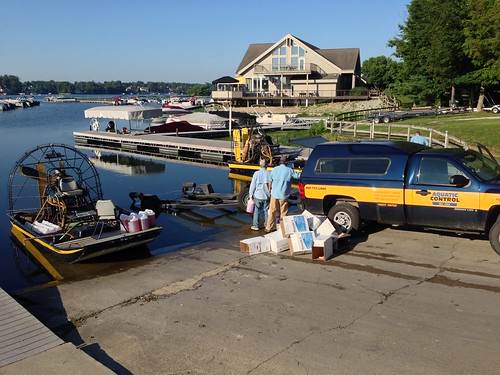
Geist Reservoir turns 70 years old this summer, and like any body of water or land-loving amphibian, it’s starting to show the effects of aging.
Our lake’s health was first called into question in 2007 when we learned of toxic blue green algae blooms, resulting in warnings that scared many boaters out of the water. In 2010, Zebra mussels were found in the reservoir, threatening to clog drains and attach themselves to boats, docks, and props. Perhaps the most noticeable signs of aging have occurred over the last two years with the proliferation of algae and invasive Eurasian milfoil. Something has to be done, and the Geist Lake Coalition (www.GeistLake.org) is stepping up its efforts to preserve the reservoir and subsequent property values of everyone in the greater Geist community.
Late last year, the GLC applied for a Lake and River Enhancement grant (LARE) to treat Geist for Eurasian milfoil. Scott Rodgers, a founding board member of the GLC and member of the Upper White River Watershed Alliance, spearheaded the effort that netted the GLC a $5,000 matching grant to embark on a pilot program in 2013. While the $5,000 from LARE is low, historically, once it starts funding a project, LARE sticks with it and sometime increases its contributions. Donations collected during this year’s Blast on the Bridge covered the $5,000 matching portion of the LARE grant, and additional monies were committed to treating our ailing patient. Finally, the Town of Fishers also chipped in $15,000 to be used on milfoil on the north half of the lake.
With some seed money in hand, GLC President Brian Hall began the process of nailing down needed permits from the Department of Natural Resources and the Indiana Department of Environmental Management to treat nearly 70 acres of the most-affected shorelines, coves, and access areas. Meanwhile, calls and emails started coming in from around the lake looking for a miracle drug to fight the algae and milfoil problem. “With only $5,000 from LARE and $5,000 from the GLC, we knew that we’d have to raise a lot of money privately as quickly as possible,” said Hall. “The conditions were deteriorating by the day, so we had to move fast to get treatments started.”

In March, Hall painstakingly went through aerial images of Geist Reservoir, identifying problem areas to formulate a request for proposal to treat the worst of the worst areas. After reviewing competitive bids, Aquatic Control (headquartered in Seymour, Indiana) was selected, and made the first house call to Geist Reservoir. After submitting a map highlighting the hotspots, Hall went looking for funding from homeowners willing to back up their concerns with dollars. Approximately 38 acres in five key areas south of the Fall Creek Bridge were treated July 12 for milfoil and algae.
Discussions with residents in Cambridge and Masthead II near the Fall Creek Road causeway followed, with Hall and company passing the hat for more monies to fund other affected areas. “Managing expectations during this pilot phase is tough to do,” said Hall. “There are several native plants that people see in the lake that are actually good for the ecosystem. Not everything in the water needs to or should be treated.” Coontail and duck weed are two such plants. Neither takes root nor poses any threat to Geist Reservoir. They might be green, and in the case of coontail, mistaken for milfoil, but they are not harmful and should not be treated.

Short term, the GLC is soliciting donations direct from homeowners, neighborhood groups and home owner associations that are looking to get their shorelines or coves cleaned up. They are hoping to learn more about the types of treatments that respond the best, the frequency of applications, and which neighborhoods or organizations should align together for a longer-term strategy. Rodgers admitted that treating the problem with chemicals is a delicate balance that has been vetted by IDEM, DNR and Citizens Energy Group. “We are in triage mode right now with this milfoil problem, and we are seeking the best long term solutions. It is all part of a complex and intertwined puzzle where erosion, sedimentation, invasive aquatic plants and species like Zebra mussels come into play. Add to that, fertilizers and other pollutants feeding into the lake via storm drains from neighborhoods surrounding the general Geist area – all have brought us to this point,” added Rodgers.
Residents and neighborhood associations that would like to participate yet this summer in the pilot program should contact the GLC through its website at www.GeistLake.org. Also, individuals, companies, neighborhood associations, and residents who would like to serve as volunteers with the GLC should also sign up via the website.
This is not just an issue for those living on the water. Everyone who lives, shops, or calls Geist Reservoir home is affected by the health of the lake. Visiting hours are open and we all need to pull together to stabilize and save our shared neighbor and patient, Geist Reservoir.






Comments 1